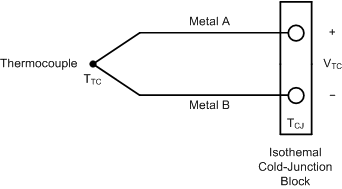SBAA274A September 2018 – March 2023 ADS1118 , ADS1119 , ADS1120 , ADS112C04 , ADS112U04 , ADS1146 , ADS1147 , ADS1148 , ADS114S06 , ADS114S06B , ADS114S08 , ADS114S08B , ADS1219 , ADS1220 , ADS122C04 , ADS122U04 , ADS1246 , ADS1247 , ADS1248 , ADS124S06 , ADS124S08 , ADS125H02 , ADS1260 , ADS1261 , ADS1262 , ADS1263
- A Basic Guide to Thermocouple Measurements
- Trademarks
- 1Thermocouple Overview
-
2Thermocouple Measurement Circuits
- 2.1 Thermocouple Measurement With Pullup and Pulldown Bias Resistors
- 2.2 Thermocouple Measurement With Biasing Resistors Attached to the Negative Lead
- 2.3 Thermocouple Measurement With VBIAS for Sensor Biasing and Pullup Resistor
- 2.4 Thermocouple Measurement With VBIAS For Sensor Biasing and BOCS
- 2.5 Thermocouple Measurement With REFOUT Biasing and Pullup Resistor
- 2.6 Thermocouple Measurement With REFOUT Biasing and BOCS
- 2.7 Thermocouple Measurement With Bipolar Supplies And Ground Biasing
- 2.8 Cold-Junction Compensation Circuits
- 3Summary
- 4Revision History
1.1 Seebeck Voltage
In 1820, Thomas Johann Seebeck discovered that when a metal bar is heated on one end, a voltage (known as the Seebeck voltage) develops across the length of the bar. This voltage varies with temperature and is different depending on the type of metal used in the bar. By joining dissimilar metals that have different Seebeck voltages at a temperature sensing junction, a thermocouple voltage (VTC) is generated.
The dissimilar metals are joined at a temperature sensing junction (TTC) to create a thermocouple. The voltage is measured at a reference temperature (TCJ) through the two metals. The leads of the thermocouple are required to be at the same temperature and are often connected to the ADC through an isothermal block. Figure 1-1 shows a thermocouple constructed from two dissimilar metals with the thermocouple leads connected to an isothermal block.
 Figure 1-1 Thermocouple Voltage
Figure 1-1 Thermocouple VoltageThe connection of the thermocouple to an isothermal block is important for the temperature measurement. For an accurate thermocouple measurement, the return leads of different metals must be at the same known temperature.
Any connection between two different metals creates a thermocouple junction. Connections from the thermocouple to the ADC should be simple and symmetric to avoid unintentional thermocouple junctions. These additional junctions cause measurement errors.
As the thermocouple signal connects to the ADC integrated circuit, each step along the path can encounter several additional thermocouples. This becomes a measurement problem if there is a temperature gradient across the circuit. Each connection from wire terminal, to solder, to copper trace, to IC pin, to bond wire, to chip contact creates a new junction. However, if the signal is differential, and each of the thermocouple pairs are at the same temperature, then the thermocouple voltages cancel and have no net effect on the measurement. For high-precision applications, the user must ensure that these assumptions are correct. Measurement with differential inputs include unintentional thermocouple voltages that do not cancel if the thermocouples are not located close together, or if there is a thermal gradient on the board or device.